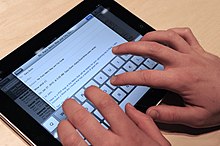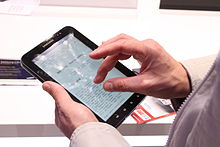Tablet computer
![]()
Tablet is a redirect to this article. For the Scottish confectionery see Tablet (confectionery).
A tablet ( ![]() ) (English tablet 'writing tablet', US-English tablet "notepad") or tablet computer, tablet PC, rarely also flat computer, is a portable, flat computer in particularly light design with a touch screen, but, unlike notebooks, without a fold-out mechanical keyboard. A tablet is a special design of a personal computer, which belongs to the handheld devices.
) (English tablet 'writing tablet', US-English tablet "notepad") or tablet computer, tablet PC, rarely also flat computer, is a portable, flat computer in particularly light design with a touch screen, but, unlike notebooks, without a fold-out mechanical keyboard. A tablet is a special design of a personal computer, which belongs to the handheld devices.
Due to the light construction and the touch-sensitive screen, tablets are characterized by a different handling than computers equipped with more extensive control elements. The devices are similar to modern smartphones in terms of performance, operation and design and usually use operating systems originally developed for smartphones. Because of the on-screen keyboard, which is only displayed when needed, tablets are less suitable for writing large amounts of text.
Tablets are usually equipped with permanently installed batteries that often cannot even be replaced by qualified personnel, which means that inexpensive devices equipped with inferior batteries can very quickly become hazardous waste. This is partly planned by the manufacturers.
Wired connection to external devices is only provided for in a few tablet PCs, so Bluetooth and WLAN are standard equipment. In addition, many devices are also offered with an integrated modem (including UMTS or LTE as data radio), which means that they can be used for mobile telephony without having to rely on an external mobile modem (e.g. via a USB port).
Tablets are also increasingly used for remote control of digital devices, such as cameras, AV receivers, TVs or quadrocopters.
The functional range of a tablet can be extended by additional programs (called apps). Tablet journalism is becoming increasingly important, with the tablet being used as an information medium to consume journalistically prepared media content or, in some cases, to create it oneself.

Apple iPad with on-screen keyboard

Android tablet Samsung Galaxy Tab
Development
Concepts and design studies for this type of device have existed since the late 1980s. One of the first devices of this type was the GRiDPad from GRiD Systems in 1989, which, however, was not able to achieve great market significance. At the beginning of their development, the devices known as Personal Digital Assistants (PDA) were mainly limited to calendar, address and task management due to the technical possibilities and the lack of broadband mobile Internet access. For a long time in the 1990s, the market was dominated by PDAs or organizers from the Palm company (such as the Palm Pilot), which were operated using a stylus and handwriting recognition.
In 2001, the SIMpad, a Microsoft tablet PC launched on the market by the German manufacturer Siemens in Switzerland, was marketed under the term Surfpad. In Germany, this device was introduced by the network operator Telekom under the name T-Sinus Pad. The name was chosen to distinguish it from mobile Internet devices without or with limited multimedia capability, e.g. mobile phones with WAP support. The booting of the operating system ends in a web browser and already loads user-specific web content into the user interface adapted for surfing the Internet during system startup. But none of these devices could hold their own on the market.
In 2010, the US manufacturer Apple launched the iPad and achieved a breakthrough for this product category with a major sales success. Numerous other manufacturers followed with similar devices, which ultimately resulted in significant market changes in the area of portable computers. In particular, sales of notebook PCs and netbooks declined significantly in favor of tablets.

Pen tablet PC anno 1996: Stylistic 1000
Imágenes principales
The design is sometimes also referred to as a pad or surfpad. In this device class, one often finds single-chip systems with embedded operating systems. The device consists of a monolithic block, which contains the display and all other components. There are only a few interfaces for peripheral devices. Sometimes there is only one interface, which provides standard interfaces such as USB or VGA via adapters. The displays are often capacitive touchscreens, which is why the devices can only be operated with the fingers or special input pens. The manufacturer Lenovo relies on an integrated projector as an additional output device in the Yoga Tablet 2 Pro model.
Questions and Answers
Q: What is a tablet computer?
A: A tablet computer is a type of computer that can be carried easily and has no physical keyboard or trackpad. It is usually controlled by using its touchscreen with multi-touch technology similar to a smartphone.
Q: How big are the screens on tablets typically?
A: The screen size of tablets can range from 7 inches (18 cm) to 12 inches (30 cm), but many have a screen size of about 10 inches (25 cm) diagonal.
Q: Can tablets access the Internet?
A: Yes, almost all tablet computers can access the Internet using Wi-Fi, and many can use mobile phone networks like 2G, 3G, 4G, and 5G.
Q: What other features do tablets have?
A: Tablets often have high definition displays with less reflection, Bluetooth radio for connecting to printers and other devices, flash memory storage, and cloud storage services for backing up information on the tablet and synchronizing data.
Q: When did science fiction start putting tablets in stories?
A: Science fiction started putting tablets in stories after the middle 20th century.
Q: When was the Apple iPad released?
A: The Apple iPad was released in 2010.
Q: What happened after the release of the Apple iPad?
A: After the release of the Apple iPad there was much attention given to it which led to other companies making and selling more tablets.
Search within the encyclopedia